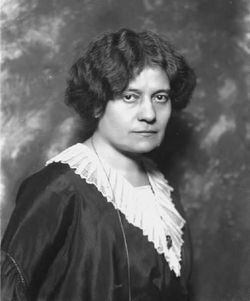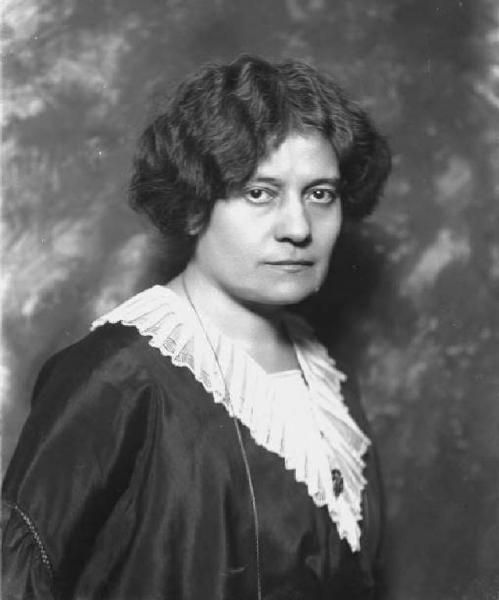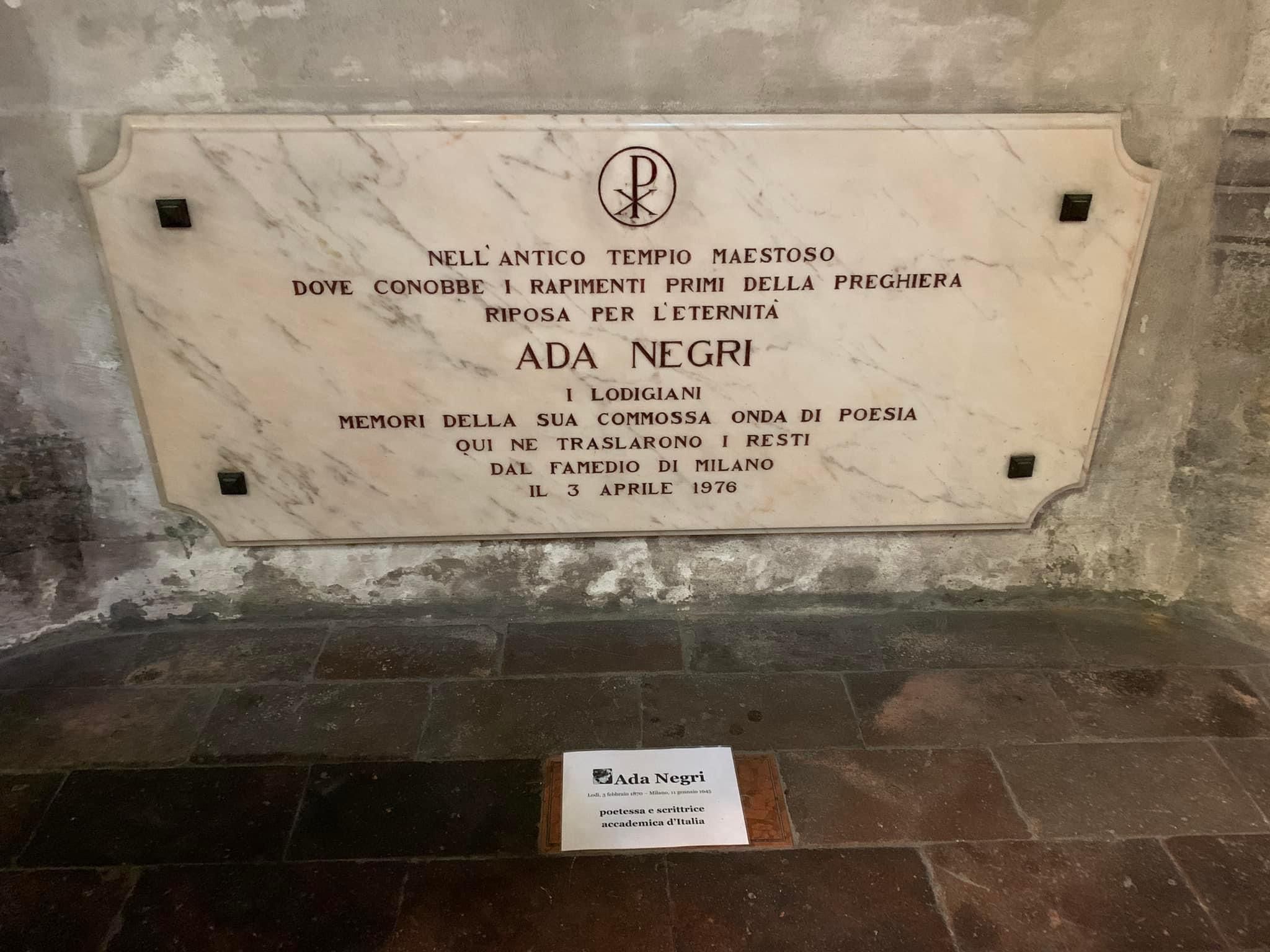Author. She was an Italian poet and author who was the first and only woman to be admitted to the short-lived Academy of Italy. She published ten volumes of poetry, eight prose stories and one novel. Born into a humble family, her grandmother, Giuseppina "Peppina" Panni, became her care giver in 1871 after her father's death and her mother becoming a factory worker. She had a lonely childhood as her grandmother was a nanny for a noble household. After attending a girls' school, Scuola Normale, she earned an elementary teacher's diploma and, at age eighteen, began teaching in a village school with unruly peasant children. She began to write poetry which was published in local newspapers and eventually in the magazine, "llustrazione Popolare." With the publication of her book of verse "Fatalita" in 1892, she became an overnight success as the voice of the working-class, protesting injustices from her first-hand experiences. She was living in a time of unstable politics in Italy. She was awarded the Milli Prize for poetry in 1894. She became known as the "Red Maiden" and her book was banded by the Roman Catholic Church. Her second collection of poetry was "Tempests" in 1896. She married a wealthy industrialist, Giovanni Garlanda in 1896. The couple had two daughters with one dying in infancy. She continued to write and be involved with politics, of which her husband did not approve. Her 1904 collection "Maternity" was not about motherhood but finding true love and the death of a child. Although the couple had been living apart for about ten years, she formally separated from her husband in 1913 in Switzerland. After the separation, she published the collection of poetry "Exile" in 1914 and a collection of short stories about unhappy women, "Solitary Women" in 1917. While in Switzerland, she fell in love, yet the man died within a year during the Spanish influenza pandemic of 1918. Following her return to Italy, this event released a great passion and grief, which inspired the very personal collection of poetry "Il libro di Mara" or "Mara's Book" in 1919. After her daughter's wedding, she wrote the successful autobiographical novel, "Stella Mattutina" in 1921. This book sold over 60,000 copies between 1921 and 1943. In 1930, the novel was published in English as "Morning Star." For her literary accomplishments, she was nominated in 1926 and in 1927 for the Nobel Prize in Literature. Italian dictator Mussolini made the 1926 nomination. Her verses were being used as lyrics for music compositions. This followed with "High Windows," a 1923 collection of short stories, her 1925 poetry collection "Songs of the Island" as well as several more books of poetry. Her poetry was being translated to English and published in the United States in newspapers. She was awarded the Mussolini Award in 1931; published "The Gift in 1936, which earned her the Firenze Prize; and in 1940 admitted to the Academy of Italy. Among her other accolades, she received the Gold Medal of the Ministry of Education for her poetry in 1938. Her accolades were a blemish on her reputation since members of the Academy of Italy had to swear loyalty to the Fascist regime and were rewarded with various material benefits by the regime. For two decades in Fascist Italy, she wrote, on various subjects including politics, a column for newspapers, which had a following of readers. She was given a small government pension and allowed to travel first class on the Italian trains. Living through World War II was a horrendous experience for her, moving from place to place to avoid actual combat zones. Her last two books were published posthumously: in 1946, a collection of poetry "Fons amoris" or "Fountain of Love", which was about the desire for peace and in 1947, the collection of short stories "Oltre" or "Beyond", which was hagiographically the lives of two saints. Originally interred in the Milan Monumental Cemetery, her remains were moved to the ancient Church of San Francesco in Lodi on April 3, 1976.
Author. She was an Italian poet and author who was the first and only woman to be admitted to the short-lived Academy of Italy. She published ten volumes of poetry, eight prose stories and one novel. Born into a humble family, her grandmother, Giuseppina "Peppina" Panni, became her care giver in 1871 after her father's death and her mother becoming a factory worker. She had a lonely childhood as her grandmother was a nanny for a noble household. After attending a girls' school, Scuola Normale, she earned an elementary teacher's diploma and, at age eighteen, began teaching in a village school with unruly peasant children. She began to write poetry which was published in local newspapers and eventually in the magazine, "llustrazione Popolare." With the publication of her book of verse "Fatalita" in 1892, she became an overnight success as the voice of the working-class, protesting injustices from her first-hand experiences. She was living in a time of unstable politics in Italy. She was awarded the Milli Prize for poetry in 1894. She became known as the "Red Maiden" and her book was banded by the Roman Catholic Church. Her second collection of poetry was "Tempests" in 1896. She married a wealthy industrialist, Giovanni Garlanda in 1896. The couple had two daughters with one dying in infancy. She continued to write and be involved with politics, of which her husband did not approve. Her 1904 collection "Maternity" was not about motherhood but finding true love and the death of a child. Although the couple had been living apart for about ten years, she formally separated from her husband in 1913 in Switzerland. After the separation, she published the collection of poetry "Exile" in 1914 and a collection of short stories about unhappy women, "Solitary Women" in 1917. While in Switzerland, she fell in love, yet the man died within a year during the Spanish influenza pandemic of 1918. Following her return to Italy, this event released a great passion and grief, which inspired the very personal collection of poetry "Il libro di Mara" or "Mara's Book" in 1919. After her daughter's wedding, she wrote the successful autobiographical novel, "Stella Mattutina" in 1921. This book sold over 60,000 copies between 1921 and 1943. In 1930, the novel was published in English as "Morning Star." For her literary accomplishments, she was nominated in 1926 and in 1927 for the Nobel Prize in Literature. Italian dictator Mussolini made the 1926 nomination. Her verses were being used as lyrics for music compositions. This followed with "High Windows," a 1923 collection of short stories, her 1925 poetry collection "Songs of the Island" as well as several more books of poetry. Her poetry was being translated to English and published in the United States in newspapers. She was awarded the Mussolini Award in 1931; published "The Gift in 1936, which earned her the Firenze Prize; and in 1940 admitted to the Academy of Italy. Among her other accolades, she received the Gold Medal of the Ministry of Education for her poetry in 1938. Her accolades were a blemish on her reputation since members of the Academy of Italy had to swear loyalty to the Fascist regime and were rewarded with various material benefits by the regime. For two decades in Fascist Italy, she wrote, on various subjects including politics, a column for newspapers, which had a following of readers. She was given a small government pension and allowed to travel first class on the Italian trains. Living through World War II was a horrendous experience for her, moving from place to place to avoid actual combat zones. Her last two books were published posthumously: in 1946, a collection of poetry "Fons amoris" or "Fountain of Love", which was about the desire for peace and in 1947, the collection of short stories "Oltre" or "Beyond", which was hagiographically the lives of two saints. Originally interred in the Milan Monumental Cemetery, her remains were moved to the ancient Church of San Francesco in Lodi on April 3, 1976.
Bio by: Linda Davis
Advertisement



